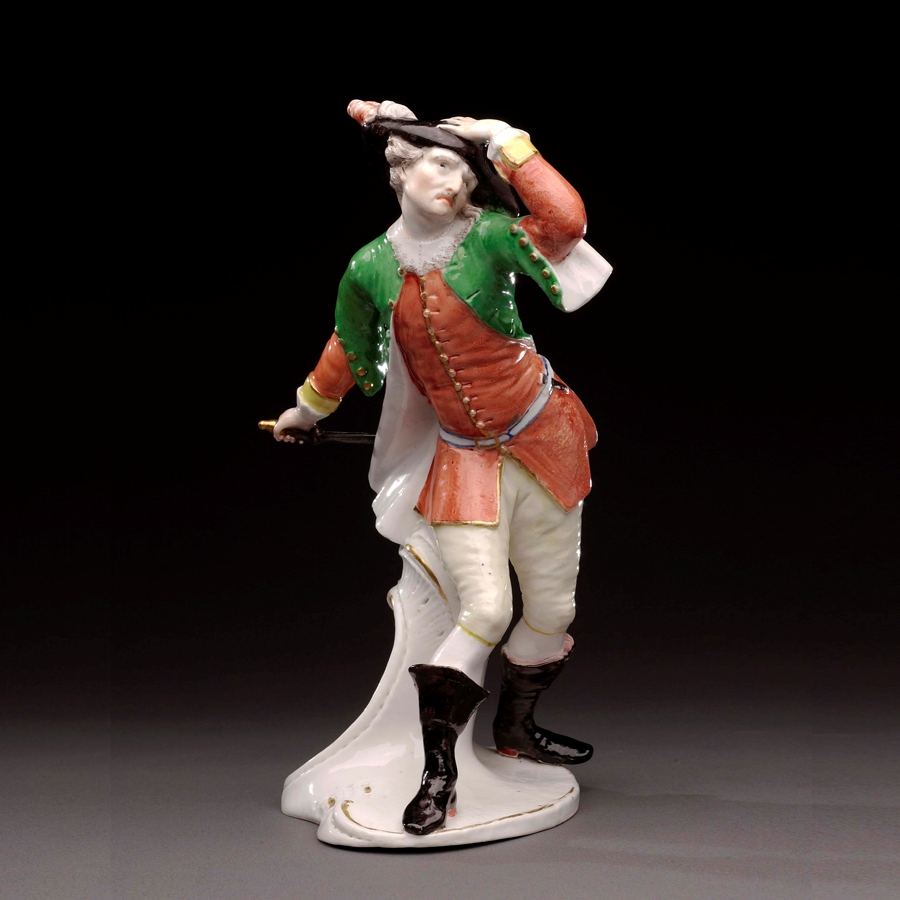

Marks
c.3.m.1.Q.3 in underglaze-blue, incised o.
Measurements
19 cm
Condition
Restoration to left thigh and right shoulder
Vigorously and crisply modelled showing the military man drawing his sword and holding his feathered black tricorn hat with his left hand. He is wearing breeches in pale yellow, and a gilt-edged iron-red coloured jacket with lace collar under a brilliant green overcoat. A dagger tucked into his blue-edged white belt, black boots, the flat base and support modelled with rocailles outlined in gilding.
Provenance
The Levi collection,
Property of a Gentleman (Christie’s London, 2nd and 3rd July 1956, lot 78)
Private Collection, New York
Other coloured examples
Munich, Bayerisches Nationalmuseum;
Formerly Trento, Kaumheimer collection, sold at Chrisite’s London December 2004;
Hamburg, Museum f. Kunst u. Gewerbe;
Hamburg, Museum f. Kunst u. Gewerbe – formerly Otto and Magdalena Blohm collection;
Notes
Bustelli’s sixteen figures from the Commedia del Arte form his most important artistic achievement. They were freely modelled and not copied after engravings and show great similarity to the works of Johann B. Straub and Ignaz Guenther. The moulds for these figures appear in the Nymphenburg factory’s list of moulds for the first time in 1760.
All moulds of Nymphenburg
The Commedia del Arte was a theatrical play invented in Italy during the 15th C. Contrary to the French version, there were no fixed texts but a number of actors would enact characteristics and certain behaviours of people. They stand in recognized relation to each other and developed the play as they went along. After the death of Louis XIV, the Italian Comedy enjoyed great popularity in France, Germany and other European countries which introduced new characters which were adapted to their national peculiarities. This vogue was reflected in many European porcelain factories. Capitano is shown here in his costume of a Spanish Invader about to fight Octavio, his rival for the love of the beautiful and rich Isabella. During the Spanish domination in Italy he aquired the name ‚Matamoros‘.
For the family tree of the Captain and a detailed discussion of his history, development of character and behaviour, see P. L. Duchartre, „The Italian Comedy“, pp. 225-250.
Literature
For other examples of this model, see F. H. Hofmann, Nymphenburg, Vol. I, p.88, fig. 84, formerly in the collection of Mrs. E. Hirth, Muenchen. Subsequently sold as the property of O.J.R. Brookman Esq at Sotheby’s, London, 13 November, 1962, Lot 147.
M. Sauerlandt, Deutsche Porzellanfiguren aus dem 18. Jahrhundert, 1923, p. 56.
Another polychrome example, showing the Capitano clutching a dagger in his right hand, was sold at Sotheby’s, London, 23 May, 1967, lot 98. A similar example in a German private collection is illustrated by R.Rueckert, „Bustelli“, pl. 34.
